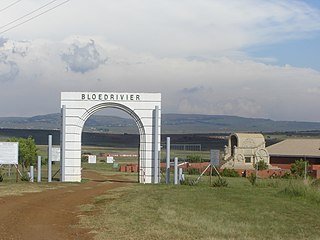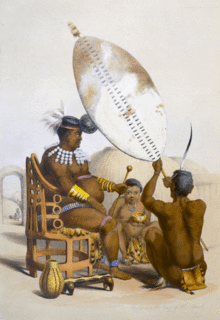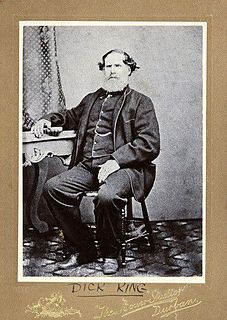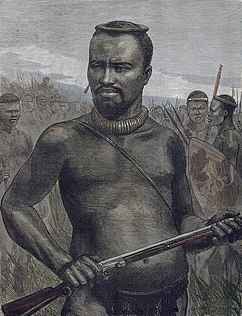
The Anglo-Zulu War was fought in 1879 between the British Empire and the Zulu Kingdom. Following Lord Carnarvon's successful introduction of federation in Canada, it was thought that similar political effort, coupled with military campaigns, might succeed with the African kingdoms, tribal areas and Boer republics in South Africa. In 1874, Sir Henry Bartle Frere was sent to South Africa as High Commissioner for the British Empire to bring such plans into being. Among the obstacles were the presence of the independent states of the South African Republic and the Kingdom of Zululand and its army.

Dingane kaSenzangakhona Zulu —commonly referred to as Dingane or Dingaan—was a Zulu chief who became king of the Zulu Kingdom in 1828. He set up his royal capital uMgungundlovu, and one of numerous military encampments or kraals, in the Emakhosini valley just south of the White Umfolozi River on the slope of Lion Hill (Singonyama).

The Battle of Blood River is the name given for the battle fought between 470 Voortrekkers ("Pioneers"), led by Andries Pretorius, and an estimated "10,000 to 15,000" Zulu on the bank of the Ncome River on 16 December 1838, in what is today KwaZulu-Natal, South Africa. Casualties amounted to over 3,000 of King Dingane's soldiers dead, including two Zulu princes competing with Prince Mpande for the Zulu throne. Three Pioneer commando members were lightly wounded, including Pretorius.

Mpande (1798–1872) was monarch of the Zulu Kingdom from 1840 to 1872, making him the longest reigning Zulu king. He was a half-brother of Sigujana, Shaka and Dingane, who preceded him as kings of the Zulu. He came to power after overthrowing Dingane in 1840.

Cetshwayo kaMpande was the king of the Zulu Kingdom from 1873 to 1879 and its leader during the Anglo-Zulu War of 1879. His name has been transliterated as Cetawayo, Cetewayo, Cetywajo and Ketchwayo. He famously led the Zulu nation to victory against the British in the Battle of Isandlwana.

John Robert Dunn was a South African settler, hunter, and diplomat of British descent. Born in Port Alfred in 1834, he spent his childhood in Port Natal/Durban. He was orphaned as a teenager, and lived in native dress on the land near the Tugela River. His conversance with Zulu customs and language allowed his increasing influence among Zulu princes. In addition he was able to identify and exploit various opportunities for trade. He represented both colonial and Zulu interests, and rose to some influence and power when Cetshwayo became the Zulu sovereign. He acted as Cetshwayo's secretary and diplomatic adviser and was rewarded with chieftainship, land, livestock and two Zulu virgins. In the run-up to the Zulu War, he was served with an ultimatum by the British at the same time as Cetshwayo. He had to forgo any position of neutrality and sided with the British. In the aftermath he was allocated land in a buffer zone between the colony and Zululand. Besides his first wife Catherine, he took many Zulu women as wives and left a large Christian progeny when he died at age 60 or 61.

The Natalia Republic was a short-lived Boer republic on the coast of Southern Africa, established in 1839 by Voortrekkers shortly after the Battle of Blood River. The area was ceded by the Zulu king Dingane to Piet Retief and his party in 1838 and stretched from the Tugela River to present day Port St. Johns. It was previously named Natália by Portuguese sailors. The republic was annexed by Britain in 1843 to form the Colony of Natal. After the British annexation of the Natalia Republic, most local Voortrekkers trekked north into Transorangia, later known as the Orange Free State, and the Transvaal.
Ndlela kaSompisi was a key general to Zulu Kings Shaka and Dingane. He rose to prominence as a highly effective warrior under Shaka. Dingane appointed him as his inDuna, or chief advisor. He was also the principal commander of Dingane's armies. However, Ndlela's failure to defeat the Boers under Andries Pretorius and a rebellion against Dingane led to his execution.
The Zulu royal family consists of the reigning monarch of the Zulus of South Africa, King Goodwill Zwelithini kaBhekuzulu, his consorts, legitimate descendants, near relatives and male-line descendants of his great-great-grandfather, King Mpande who, as a half-brother of the Zulu Pater Patriae, King Shaka, reigned from 1840 to 1872. Shaka's policies and conquests transformed a small clan into one of South Africa's most influential pre-colonial realms, extending over much of what is now KwaZulu-Natal.

Sigananda kaZokufa was a Zulu aristocrat whose life spanned the reigns of four Zulu kings in southeastern Africa. In an address by Mangosuthu Buthelezi at Endlamadoda-Nkandla on 15 September 2001 he said that Inkosi Sigananda's grandfather was Inkosi Mvakela, who married a sister of Nandi, King Shaka's mother, and that his father was Inkosi Zokufa. He also said he had a son called Ndabaningi. At this occasion he unveiled a monument to Inkosi Sigaganda.

Richard Philip "Dick" King (1811-1871) was an English trader and colonist at Port Natal, a British trading station in the region now known as KwaZulu-Natal. He is best known for a historic horseback ride in 1842, where he completed a journey of 960 kilometres (600 mi) in 10 days, to request help for the besieged British garrison at Port Natal.

The Kingdom of Zulu, sometimes referred to as the Zulu Empire or the Kingdom of Zululand, was a monarchy in Southern Africa that extended along the coast of the Indian Ocean from the Tugela River in the south to Pongola River in the north.

Dabulamanzi kaMpande was a Zulu commander in the Anglo-Zulu War, most noted for commanding the Zulus at the Battle of Rorke's Drift. He was a half-brother of the Zulu king Cetshwayo kaMpande.

uMgungundlovu was the royal capital of the Zulu King Dingane (1828–1840) and one of several military complexes (amakhanda) which he maintained. He established his royal kraal in 1829 in the eMakhosini valley against Lion hill (Singonyama), just south of the White Umfolozi River.

Child of Storm is a 1913 novel by H. Rider Haggard featuring Allan Quatermain. The plot is set in 1854-56 and concerns Quatermain hunting in Zululand and getting involved with Mameema, a beautiful African girl who causes great turmoil in the Zulu kingdom.

The Battle of Maqongqo was fought on 29 January 1840 during a civil war between Zulu factions. The Zulu king Dingane was challenged for the throne by his brother Mpande, in alliance with Boer settlers led by Andries Pretorius. Mpande and his supporters were victorious. Shortly thereafter Dingane was murdered and Mpande became king of the Zulus.
Dinuzulu's Volunteers (1884) were a militant group of farmers that fought for Dinuzulu kaCetshwayo, the king of the Zulu nation, led by Louis Botha.
















